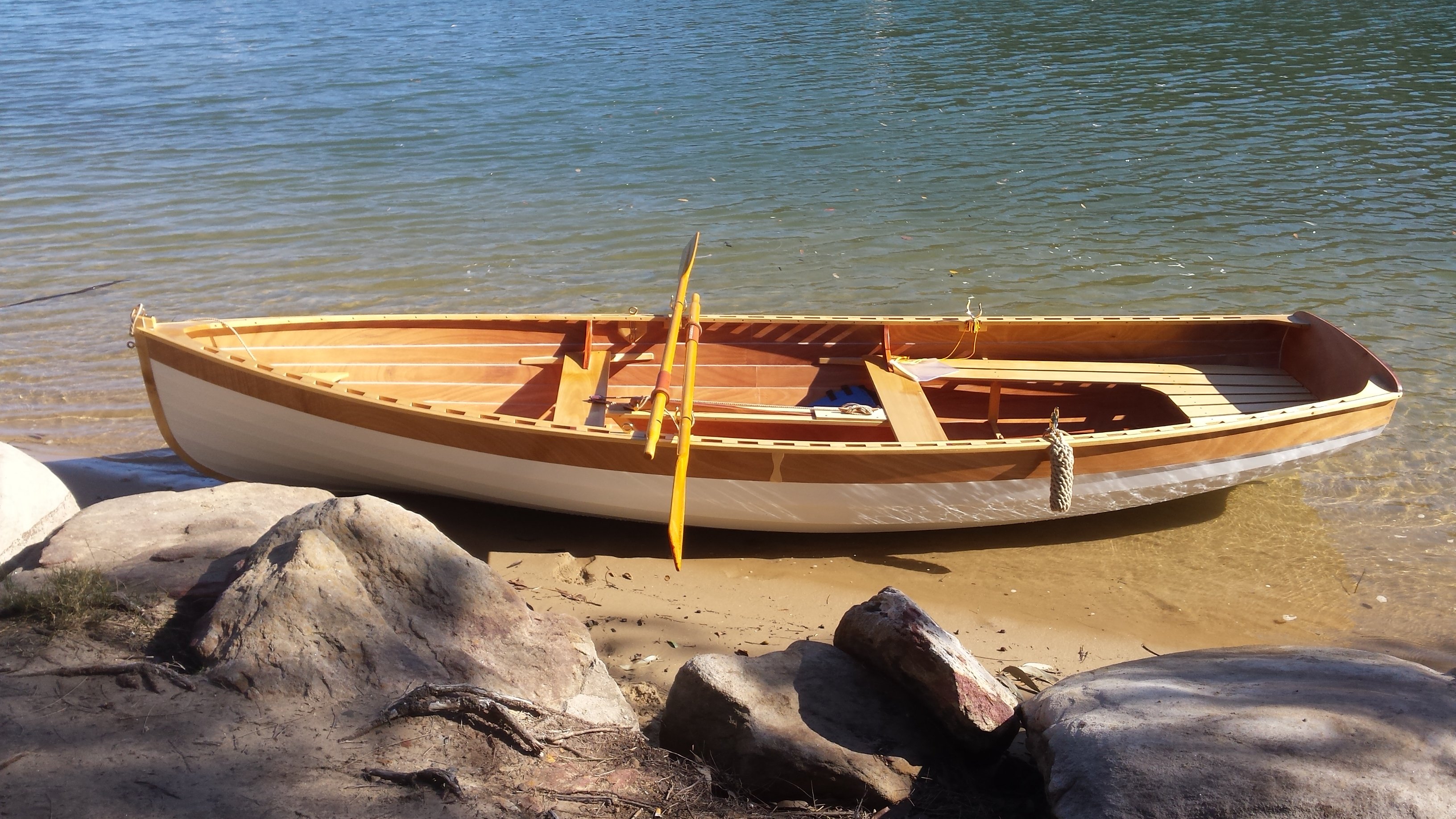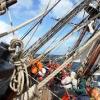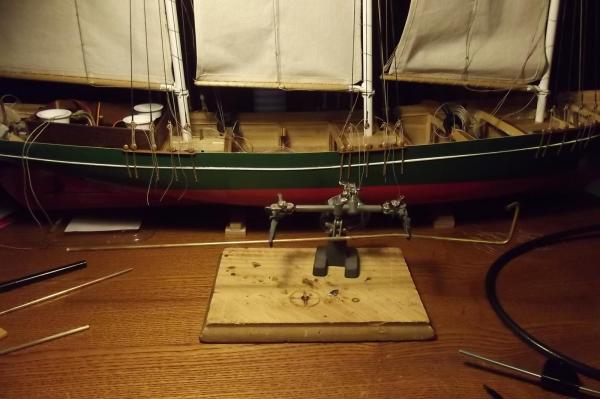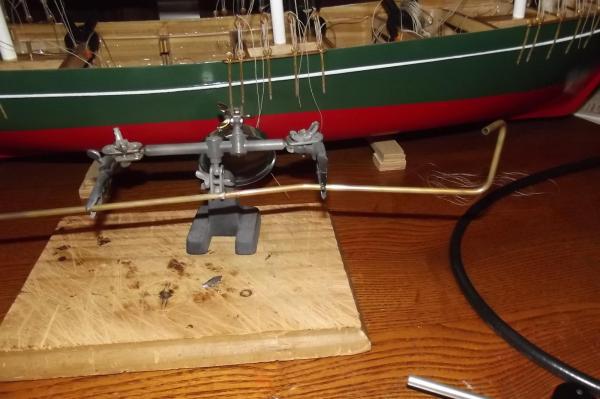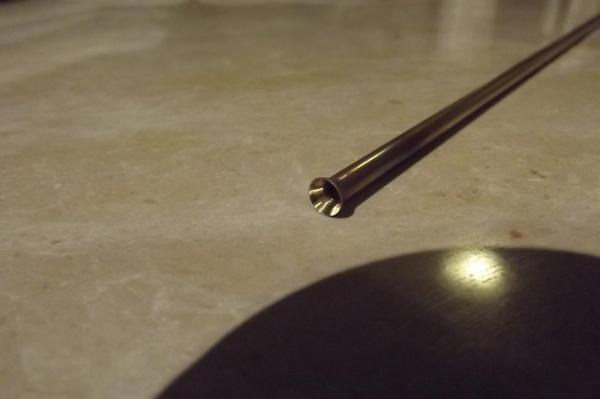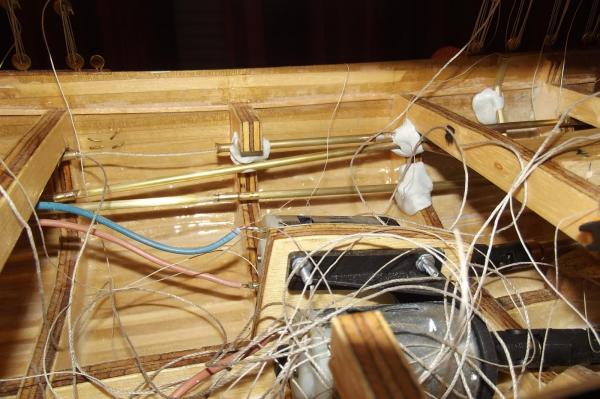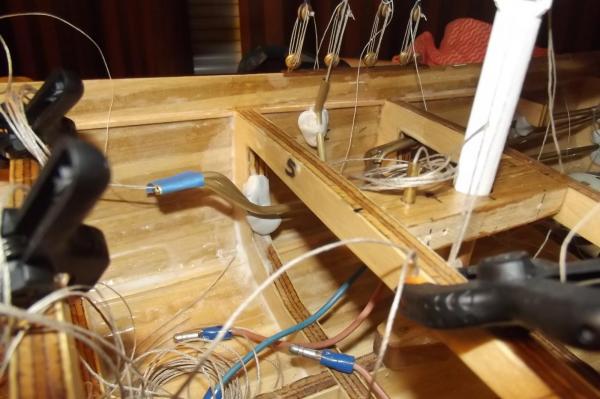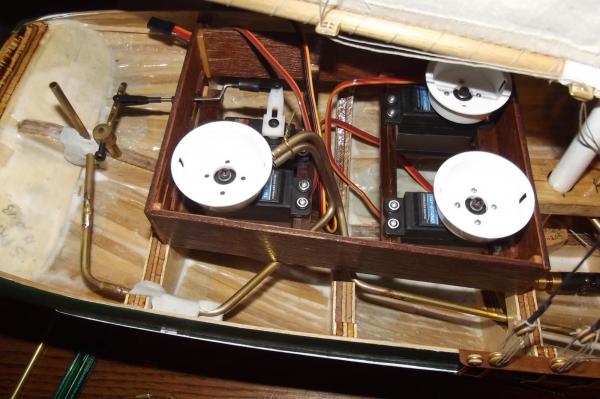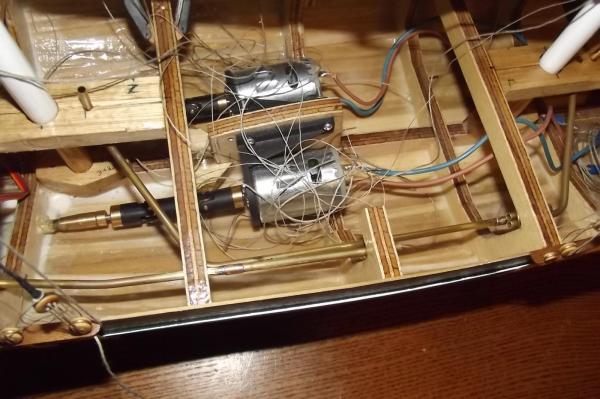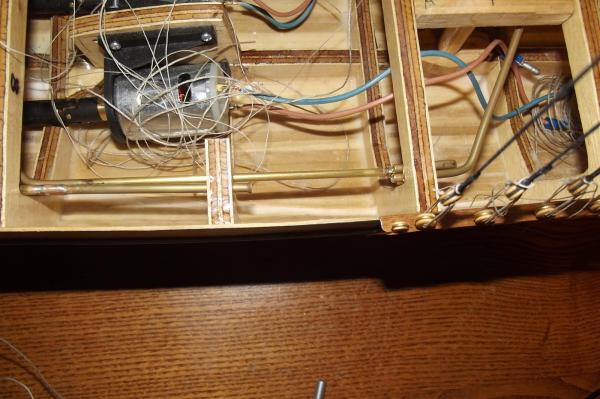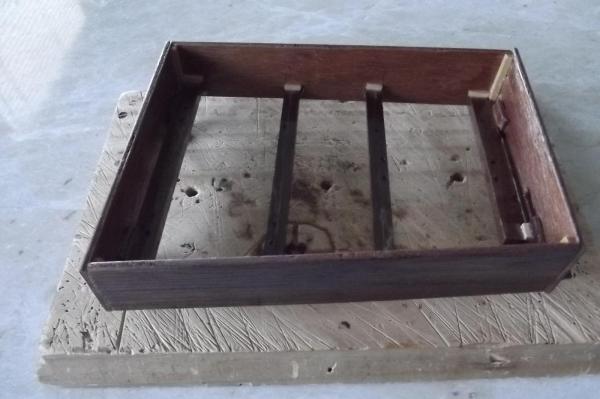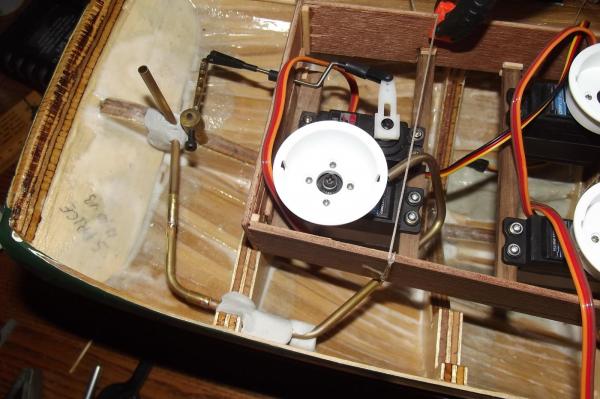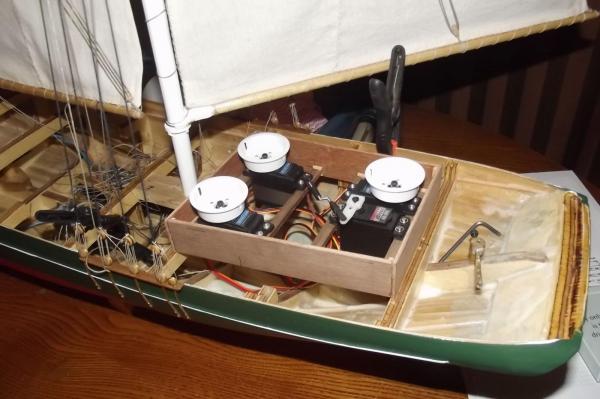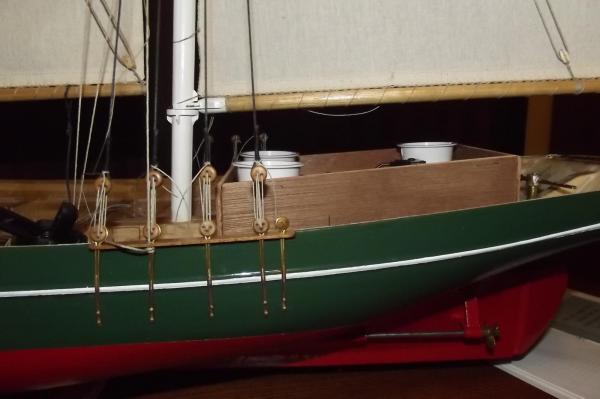-
Posts
1,285 -
Joined
-
Last visited
Content Type
Profiles
Forums
Gallery
Events
Everything posted by Bedford
-
I have been slack lately, not looking forward to the lazy jacks. I have sorted them now and I can now lower the sails properly. The video is a little bit dodgey as the camera kept trying to auto focus but it's ok. Once all the running rigging for the tops'ls is done I think it will be smoother and more controlled too.
-
Small progress it may be but it is beautiful.
- 745 replies
-
- francis pritt
- mission ship
-
(and 1 more)
Tagged with:
-
Halliards are one thing but it appears I may have a problem tacking. I put her outside in a breeze yesterday and the sails wouldn't reliably pull the line out of the tubes in a light breeze. If I let line out and the sails don't draw it through the tubes then it can foul around the winch drum. I may have to completely re-think them, possibly running them above deck through blocks and attach to the booms from either side but I see problems there too in that because the point of attachment to the boom will move in an arc the pulls will exponential rather than linear. Just another challenge for me.
-
We have reached a truly momentous occasion........... http://youtu.be/oVoMhYSnHvA I am so pleased with how the sails raise, it takes a fair bit of effort but the servo handles the task with ease. I can't lower them properly yet because I have yet to run the lazy jacks to the servo, when they are connected the gaffs will pull down easily and the bulk of the sail will be controlled rather than spilling out all over the deck.
-
First a pic of the flared tube fresh off the lathe. These are for the joined ropes from two or three masts to easily pull into the final tube back to the servo. More plumbing done, that's tacking of the courses and raising of the gafs taken care of. I have found that epoxy putty is excellent for fitting the tubes in place, easy and it allows time to adjust the position properly while getting a good hold on it fairly quickly.
-
27.5 degrees, that's about 1.5 too hot to be comfortable for me, you can keep it ! Back to ship building. The epoxy has set, the control room is re-fitted and I have done more "plumbing" I hope the pics make sense. This shows two tubes running to the winch drum, just held together with wire for now. I was going to solder them together but I am worried about the heat so I think I will use epoxy and epoxy putty to secure it all. In the following pics you can make out the two tubes from the fore and main masts coming together and aiming towards the stern. There is another tube with a flared end facing forward towards the other two. The idea being that a line off each boom will join to a single line that runs back to the winch drum. The gap between the tubes that allows for joining of the lines is located in the area of a large cargo hatch to allow repeat access should it be required. Nothing is permanently aligned yet. I flared the receiving tube to allow the join in the ropes to pass into the tube easily, I did this in the lathe. Anneal the tube then mount it in the chuck, place a centre drill in the tail stock and run the lathe in reverse while easing the centre drill into the tube. The cutting edge of the drill does not bite into the brass because the lathe is going backwards so the angled step on the drill acts as a gentle flaring tool.
-
Well wouldn't that rot your socks! When I was using epoxy in summer the stuff was going off as quickly as I could mix it and now in winter it doesn't want to go off at all! I realised that I had better pull out the control room and epoxy it for waterproofing. I did that this morning and because it is a balmy 9-10 degrees C here I left my front and back doors open to freshen up the house. After about 3 hours the epoxy was still quite tacky so I turned the heating on to 16 degrees and went out for a while, came back and still no better. I have had to turn the heat off again because it is just too warm so I will see if it goes off over night. The upshot of all this is that I can do no more control fitting until the epoxy is set and the control room re-fitted.
-
Michael, in this one instance, yes. I need to remember to pull the sail to centre and then let it out during tacking in order to keep tension on it. It will be aided by the fact that the winch drums sit inside the white cups you can see on top of the servos and the tolerances are quite close, less that the thickness of the line, so I am hoping there won't be any dramas with it. The balance of the controls will be a closed loop system so there should be no problems with them. With the possible exception of the stays'ls because they let out much further than they pull in but it won't be using a winch drum so as long as I keep the area of operation foul free I think it should be ok.
-
I'll join in on the rigging jig, nice idea. This is going to be a beauty, hope the Commodore is impressed !
- 420 replies
-
I've started the "plumbing" in earnest. I tried getting all the bends right so I could run one unbroken pipe but it's not easy to do. I always knew I would probably need to cut and re-join to adjust angles and lengths and as you can see there are two such alteration points in this run. This is the line that will control tacking on the mizzen mast, the fore and main will share one line onto the same winch.
-
Progress at last! I have worked out how to mount the servos and have done so in the aft deck house. The "box" will be epoxied to the ribs below and it holds the servos. The aft deck will be over half way up the sides of the box. Once it is all done there will be a box lid in the form of the aft deck house that will fit neatly over the control box to close it.
-
Don't you hate that, you put all that effort into making a beautiful handle for the trolley then realise you overlooked something crucial. I've done that a few times on my build. The deck does look brilliant, love it !
- 2,207 replies
-
Might I make a suggestion. The cradle on the trolley will easily allow the cutter to float off but when it comes to recovering her you are going to have a struggle locating the keel back in its slot. I would put longitudial v blocks the length of the cradle to help guide the keel home.
- 2,207 replies
-
I reckon you'll have enough left over for your next project Michael. I wish my schooner had enough draught to just add ballast internally. You'll have her under sail well before my schooner I think.
- 2,207 replies
-
Yeah, don't know how I stuffed up that calculation, I still guess about 10 Kg extra, maybe more!
- 2,207 replies
-
Love the colours Michael, she looks bang on. That shot from the waterline is excellent, all it needed was a mooring line to a bouy and you would never know she was a model. Just guessing from my experience with the schooner, your 66lbs translates into roughly 13.3Kg and looking at the waterline I'm thinking about another 8 to 10Kg or 36 to 45Lbs. Given that I am looking at her from the other side of the world I will, of course, stand correction. I have just shown your build log to my 23 year old son and he is every bit as amazed and impressed as I am at your building skills. Steve
- 2,207 replies
-
All I can say is that when I openned the first pic, the dark hull, it had a presence and a wow factor, the second pic with the white hull just didn't. Then again I am of the old school, she would have been dark when she was young so that is the way I would have her.
- 2,207 replies
-
She looks like she is just waiting for the tide to come in and float her off. Great pics
- 2,207 replies
-
Two things I take from that are that you have a MUCH easier rig to unship than I do and my schooner could almost be a tender to your cutter! That is a great pic, it really shows the size and her lines very well. She is beautiful !
- 2,207 replies
-
Michael, the beads are not sperical, they are more cylindrical so that can't happen. Wouldn't be a bad idea though. Bob, I think a lot of people who build these models are terrified of breaking them so they don't tension the rigging enough, especially the standing rigging. When you think about it though all that rigging is designed to strengthen and support the masting and even in a model it does just that so my rigging is tensioned quite well on all my ships, I do tension it gradually and evenly so as not to over tighten one side which could lead to breakage. I did read once that you should soak all the rigging cord and hang it out to dry under tension to take all the stretch out of it but I didn't do it with the first ship, built in 1997, and it is still nice and tight. I did it with the second model but don't think it made any difference so I haven't done it since. I have more to do in the garage, ie make the aft deck house to mount the servos in, but again it is way too cold, snow is looming and they are experiencing what they are referring to as a megablizzard in the snowfields not that far south of here.
About us
Modelshipworld - Advancing Ship Modeling through Research
SSL Secured
Your security is important for us so this Website is SSL-Secured
NRG Mailing Address
Nautical Research Guild
237 South Lincoln Street
Westmont IL, 60559-1917
Model Ship World ® and the MSW logo are Registered Trademarks, and belong to the Nautical Research Guild (United States Patent and Trademark Office: No. 6,929,264 & No. 6,929,274, registered Dec. 20, 2022)
Helpful Links
About the NRG
If you enjoy building ship models that are historically accurate as well as beautiful, then The Nautical Research Guild (NRG) is just right for you.
The Guild is a non-profit educational organization whose mission is to “Advance Ship Modeling Through Research”. We provide support to our members in their efforts to raise the quality of their model ships.
The Nautical Research Guild has published our world-renowned quarterly magazine, The Nautical Research Journal, since 1955. The pages of the Journal are full of articles by accomplished ship modelers who show you how they create those exquisite details on their models, and by maritime historians who show you the correct details to build. The Journal is available in both print and digital editions. Go to the NRG web site (www.thenrg.org) to download a complimentary digital copy of the Journal. The NRG also publishes plan sets, books and compilations of back issues of the Journal and the former Ships in Scale and Model Ship Builder magazines.

